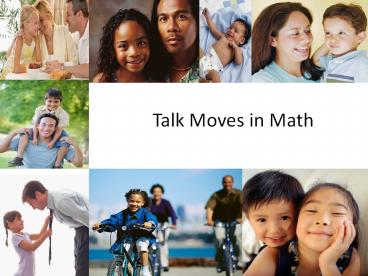Talk Moves in Math - PowerPoint PPT Presentation
1 / 14
Title:
Talk Moves in Math
Description:
Talk Moves in Math * * 2/3 of the talk in classrooms is done by teachers 2/3 of the talk is about controlling or directing Excess Teacher Talk Swamps Children Cross ... – PowerPoint PPT presentation
Number of Views:405
Avg rating:3.0/5.0
Title: Talk Moves in Math
1
Talk Moves in Math
2
Beware!!
Excess Teacher Talk Swamps Children Cross
Nagel 1969
- 2/3 of the talk in classrooms is done by teachers
- 2/3 of the talk is about controlling or directing
Carmel Crevola
3
Teacher-Centered Discussion
(Image Source http//www.icalweb.com/wiki/index.p
hp?titleClassroom_Focus)
4
Student-Centered Discussion
(Image Source http//www.icalweb.com/wiki/index.p
hp?titleClassroom_Focus)
5
Briefly, why aim for talk and discussion?
- Talk reveals understanding and misunderstanding.
- Talk supports academic language development.
- Talk supports deeper reasoning.
- Talk supports social development and
perspective taking.
6
What are Talk Moves?
- Academic talk by students and teachers.
7
Revoicing
- The teacher repeats part or all of a student's
utterance and asks the student to verify whether
the interpretation is correct. - Especially helpful to teachers when they do not
understand what was said. - Revoicing is not simply repeating, The third part
(verification) is necessary. (I infer. Is that
right? Is that correct?)
8
Say More
- Ask a student to elaborate on what she said, or
ask another student to "add on" or "say more"
about a classmate's contribution. - This move is helpful whether or not the teacher
understands the initial contribution. - Sometimes this move is overlooked because it is
so straightforward. - Students enjoy having a platform from which to
start their comment.
9
Repeat
- Students restate a contribution of a classmate
either verbatim or paraphrased. - Useful when an idea is out on the floor and
teacher wants more engagement. - Repeating, even when reformulated in your own
words, requires another layer of thinking. - It is somewhat challenging to repeat classmates'
contributions. - The expectation that students be able to repeat
contributions is useful. Students are "on call"
and must attend to conversation. - Even teachers find the task challenging in
meetings, etc. - This move changes the level at which people
listen.
10
Example or Counterexample?
- Student asked to provide an example or
counter-example of his or a classmate's
contribution. - This move is particularly useful in math, but
also in other subject areas. - Calling upon other students to provide examples
serves as an effective check for understanding. - Counterexamples are productive in math when
disproving a claim, etc.
11
Agree or Disagree
- Teacher asks student whether they agree or
disagree with a comment, then also asks why. - It is important to add the "why" when using this
move. - The yes or no question of "Do you agree or
disagree?" is a good start point to engage
students in the deeper thinking of "why? - Effective move to control and encourage close
attention to classmates' contributions.
12
Why do you think that?
- Teacher asks students to explain how or why they
came to their position. - Move can also referred to as "press for
reasoning. - Pressing can include asking why, requiring
evidence, citing text, questioning methods, etc. - Ultimate goal is to open a student's reasoning
process to the rest of the class so that others
can learn and respond.
13
Wait Time
- Teacher allows quiet thinking time for students
to develop responses. - While not technically a "talk" move, wait time is
equally important. - It is important to provide students time to
think. - Waiting for a student response may feel
uncomfortable to some, but with practice is
becomes natural. - Moving on rapidly is not always to most
beneficial choice for students. - Students who are normally quiet can provide
especially insightful responses if teacher uses
wait time. The idea that this puts undue pressure
on students is false. - This move allows more students to participate and
builds confidence in those less accustomed to
speaking out.
14
But, Where do I Start?
- Start with one move.
- The revoicing move can be introduced into
teaching without fanfare. - Students can learn revoicing techniques with
explicit coaching. - Revoicing is highly effective yet simple.
- Consider announcing to class that talk will be
used in new ways and describe what students might
expect.































